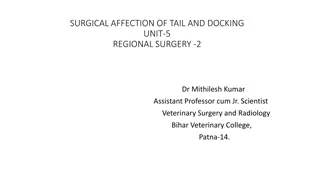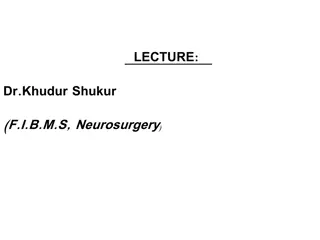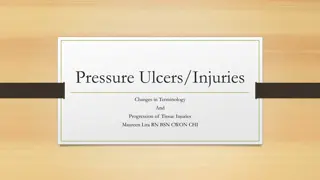Comprehensive Guide on Injury, Poisoning, and External Causes
This detailed guide covers various aspects of injuries, poisonings, and other consequences from external causes. It includes information on ICD10 and ICD9 coding, recording and treatment details, vocabulary related to different types of injuries, body parts classification, and code structures for di
2 views • 39 slides
Understanding Venous Thromboembolism in Orthopedic Patients
This educational content covers the basics of deep vein thrombosis (DVT) and pulmonary embolism (PE), including definitions, pathophysiology, risk factors, prevention strategies, diagnosis, and treatment. Traumatic and non-traumatic risk factors for VTE in orthopedic patients are discussed, emphasiz
0 views • 36 slides
Needlestick Injuries Prevention and Safety
Prevent needlestick injuries by avoiding unnecessary needle use, using devices with safety features, and implementing safe work practices. Healthcare professionals should report injuries promptly, participate in training, and get vaccinated. Be cautious when handling surgical sharps to prevent injur
5 views • 10 slides
Investigating Visual Perception Effects of Mild Traumatic Brain Injury
Elizabeth Frazier, a PhD student at Purdue University, explores the subtle effects of mild traumatic brain injury (mTBI) on cortical physiology using a novel two-alternative forced choice task in mice. The study aims to bridge visual deficits and cortical circuitry changes post-mTBI to improve diagn
0 views • 5 slides
Understanding the 3 Ts of Trauma: Trajectory, Treatment, and Trust
This comprehensive guide delves into the critical aspects of trauma - Trajectory, Treatment, and Trust. It covers the definition of trauma, PTSD symptoms, potentially traumatic events, trajectories of traumatic stress, and the impact of trauma on mental health. Explore the effects on behavior, biolo
0 views • 29 slides
Understanding Needle Stick Injuries and Prevention
Needle stick injuries are percutaneous piercing wounds caused by needles or other sharp instruments. They pose significant risks, including exposure to blood-borne diseases. Health-care workers are particularly vulnerable, with millions experiencing such injuries annually. Proper training, safe prac
0 views • 35 slides
Understanding Fractures: Traumatic vs. Pathological and Modeling Options
Defining the distinction between traumatic and pathological fractures, exploring the relationship between non-traumatic fractures and underlying bone pathologies, and discussing modeling options for classifying fractures. Stress fractures, insufficiency fractures, and the causes of pathological frac
3 views • 8 slides
Understanding Acute Knee Injuries: Meniscal Tears and Ligament Injuries
Acute knee injuries, such as meniscal tears and ligament injuries, are commonly caused by trauma or twisting motions. Meniscal tears can lead to pain, swelling, and locking of the knee joint, especially in young active individuals. Understanding the anatomy of the knee joint and meniscus, along with
1 views • 56 slides
Speech-Language Pathologist's Role in TBI Assessment & Treatment
Speech-language pathologists play a crucial role in assessing and treating traumatic brain injuries (TBI) which affect millions annually, with significant impact on children. SLPs collaborate with medical specialists, provide screenings, comprehensive evaluations, treatment development, and advocacy
0 views • 44 slides
Understanding Mild Traumatic Brain Injury and Treatment Options
Exploring the pathophysiology and clinical recovery of mild traumatic brain injury (mTBI), along with the risk factors for persisting post-concussive symptoms. The importance of diagnosing mTBI and the impact it has on individuals. Highlighting the neurometabolic cascade and functional injuries asso
0 views • 37 slides
Understanding Vehicle Collisions: Causes, Types, and Injuries
Vehicle collisions involve various types such as front impacts, side impacts, and rear-end collisions, resulting in different injuries like back and head injuries, neck injuries, soft tissue damage, broken bones, and internal injuries. Understanding the causes and effects of collisions can help prev
0 views • 14 slides
Surgical Affection of Tail and Docking - Regional Surgery Insights
An overview of surgical issues involving the tail in animals, including traumatic injuries, complications, and treatment methods like amputation. The content discusses the composition of the tail, types of injuries, predisposing factors, and the importance of proper treatment to prevent severe compl
0 views • 16 slides
Life-threatening Injuries and Emergency Response: Real-life Cases
Life-threatening incidents such as severe bleeding, blast injuries, and gunshot wounds require swift emergency medical attention. This content showcases real-life cases where expert emergency services and medical interventions saved lives in critical situations. From miraculous dressings to innovati
0 views • 25 slides
Complex Radiology Case: Multiple Traumatic Injuries in an Elderly Female
A 77-year-old female presented with multiple traumatic injuries after falling headfirst down stairs. Imaging revealed a comminuted inferior orbital wall fracture, facial lacerations, spinal fractures, and cervical cord syndrome. Lab findings indicated preexisting conditions like osteopenia, hyperten
0 views • 18 slides
Overview of Burn and Scald Injuries and Classification
Burn injuries from dry heat and scald injuries from hot liquids or steam are common forms of thermal injuries. Other etiological classifications include exposure to chemicals, electrical energy, and radiation. The extent of tissue damage is directly related to temperature and duration. Classificatio
1 views • 31 slides
Understanding Traumatic Grief and Bereavement: A Comprehensive Overview
Explore the complexities of traumatic grief, bereavement, and loss through a detailed examination of definitions, theories, stages, symptoms, impact, and risk factors. Unpack the nuances of acute grief, integrated grief, and the coping mechanisms individuals utilize when faced with profound loss. Ga
1 views • 117 slides
First Aid Tips for Common Trauma Injuries
Learn how to manage various trauma injuries such as skull fractures, eye injuries, blowout fractures, epistaxis, mouth injuries, soft tissue injuries, open injuries, and penetrating wounds with practical first aid techniques. From treating bleeding and impaled objects to saving dislodged teeth and c
0 views • 16 slides
Preventing Road Traffic Injuries: A Global Perspective
Road traffic injuries are a significant global issue, causing millions of deaths and injuries annually. This report highlights the complexity and dangers of road traffic systems, emphasizing the need for increased awareness and preventive measures at governmental, industrial, and individual levels.
1 views • 27 slides
Complications of Fractures: Types and Risks
Complications of fractures can be classified as general, local early, and late complications. General complications include shock, embolisms, and fever while local complications involve injuries to nearby tissues and infections. Early local complications can lead to visceral, vascular, nerve injurie
0 views • 29 slides
Understanding Trauma-Informed Care Training
Trauma-Informed Care Training involves understanding child traumatic stress, recognizing the effects of trauma on child development, behaviors, and functioning, as well as preventing and coping with Compassion Fatigue. It emphasizes creating safety for both providers and survivors and empowering sur
0 views • 55 slides
Understanding Mechanical Injuries: Types, Classification, and General Principles
Mechanical injuries encompass a variety of harms caused to the body, mind, reputation, or property. These injuries can be classified into medical, legal, and medico-legal categories based on factors like intentionality. The types of mechanical injuries range from blunt force trauma to thermal, chemi
0 views • 79 slides
Supporting Record-Keepers Dealing with Traumatic Records
Understanding the impact of traumatic experiences on record-keepers is crucial in training, preparing, and supporting them. Trauma, whether singular, ongoing, or complex, can be represented in records stored in archives. The potentiality of records to carry traumatic experiences requires a thoughtfu
0 views • 15 slides
Management of Closed Head Injuries in an Austere Environment Overview
Understanding the pathophysiology of brain injuries, including intracranial pressure changes and specific injuries such as traumatic brain injury (TBI), skull fractures, brain bleeds, and diffuse axonal injuries. It covers classifications, diagnosis, and treatment approaches for mild/concussion, mod
0 views • 27 slides
Understanding Foot Pathologies: Traumatic Injuries and Pressure Injuries
Explore common foot pathologies including traumatic injuries like plantar fasciitis, turf toe, and sprains, as well as pressure injuries such as plantar ulcers and heel spurs. Learn about the causes, symptoms, and treatment options for these conditions.
0 views • 33 slides
Development of a Tertiary Neurological Rehabilitation Centre in Sudan
The December Revolution Centre for Rehabilitation of Traumatic Spinal Cord and Brain Injuries at Khartoum Teaching Hospital addresses the lack of holistic patient-centered rehabilitation services in Sudan. Following the December 2018 Revolution, the need for specialized care for victims with spinal
0 views • 11 slides
Managing Traumatic Stress in Child Welfare Professionals
Learn to identify, recognize, and manage traumatic stress as an occupational hazard in the child welfare profession. This program helps professionals assess the impact of traumatic stress and personal strengths, develop strategies to promote resiliency, and understand the importance of safety and cu
0 views • 30 slides
Understanding Back Injuries and Prevention Methods
More than 1 million workers suffer from back injuries each year, accounting for a significant portion of workplace injuries. These injuries are not only painful but can also have long-term effects. It is crucial to learn how to avoid injuring or re-injuring your back to prevent pain and avoid potent
1 views • 32 slides
Understanding Pediatric Firearm Injuries and Future Research Directions
Pediatric firearm injuries are a significant public health concern, with thousands of American children affected annually. Research gaps exist in understanding the causes, consequences, and prevention strategies for pediatric firearm injuries. The lack of surveillance data and research funding hinde
0 views • 16 slides
Understanding Injuries to the Cervical and Thoracolumbar Spine
Cervical spine injuries are common, especially in the 15-30 age group, with motor vehicle accidents, falls, and sports being major causes. Male individuals are more prone to injuries. Neurological deficits are associated with specific types of injuries, necessitating prompt imaging for spinal cord i
0 views • 20 slides
Understanding Different Types of Fractures and Their Characteristics
Explore various types of fractures such as traumatic, pathologic, compressive, and more through detailed medical images and authentic reports. Learn about the severity of soft tissue damage, classifications by renowned professionals, and the significance of assessing soft tissue injuries. Delve deep
0 views • 28 slides
Understanding Pressure Ulcers and Tissue Injuries Progression
Pressure ulcers, also known as pressure injuries, are localized damages to the skin and underlying soft tissue usually over bony prominences. The National Pressure Ulcer Advisory Panel changed the terminology in 2016 to classify all stages as injuries, not just ulcers. Stages range from non-blanchab
0 views • 13 slides
The Incidence of Head and Neck Injuries in Extreme Sports
Study on the prevalence of head and neck injuries in extreme sports, specifically focusing on concussions, a common type of brain injury. The research highlights the impact and risks associated with extreme sports activities, showcasing data on traumatic brain injuries and non-fatal incidents relate
0 views • 25 slides
Understanding Birth Injuries in Newborns
Birth injuries in newborns can result from various factors during the birthing process, such as soft tissue injuries and head trauma. Soft tissue injuries like facial abrasions and scleral hemorrhage may occur due to causes like dystocia and forceps delivery. Nursing care involves assessing and reas
0 views • 19 slides
Understanding Upper Extremity Injuries and Shoulder Physiology
Upper extremities are prone to various injuries in sports, including sprains, strains, dislocations, fractures, and repetitive motion injuries like arthritis and tendonitis. The shoulder complex involves bones, muscles, tendons, ligaments, and articulations. Joints like the sternoclavicular, acromio
0 views • 63 slides
Understanding Common Sports Injuries by Dr. Ashish Kumar Dubey
Dr. Ashish Kumar Dubey, Assistant Professor in the Department of Physical Education, categorizes common sports injuries into soft tissue injuries, bone injuries, and joint injuries. Soft tissue injuries include sprains, strains, contusions, abrasions, lacerations, and incisions. Sprains are ligament
0 views • 7 slides
Understanding Dentoalveolar Injuries: Causes and Classification
Dentoalveolar injuries refer to trauma affecting the teeth and their supporting structures. These injuries can range from isolated incidents to significant maxillofacial damage. They are classified into categories based on the affected tissues, including hard dental tissues, pulp, periodontal tissue
1 views • 18 slides
Understanding Post-Traumatic Stress Disorder (PTSD) and Trauma
Post-Traumatic Stress Disorder (PTSD) is a psychological condition that may develop after a person experiences a traumatic event. Trauma can result from various incidents such as accidents, natural disasters, abuse, or war, leading to personal reactions and challenges in one's perceptions. Victims o
0 views • 104 slides
Childhood Injury Prevention: Focus on Bicycle Helmet Education in Rochester, NY
In Rochester, NY, a dedicated team aims to reduce childhood injuries by educating 6-7 year old students on the importance of wearing bicycle helmets. Through pre-and post-tests, demonstrations, and informative handouts, the program seeks to increase awareness and adherence to safety laws, ultimately
0 views • 16 slides
Overview of Peripheral Nerve Injuries and Brachial Plexus Injuries
Explore different types of peripheral nerve injuries including Erb's palsy, Klumpke palsy, isolated axillary nerve injury, and isolated musculocutaneous nerve injury. Learn about the anatomy, causes, motor and sensory exams, and management of these injuries. Understand the myotomes and dermatomes as
0 views • 19 slides
Understanding Finger Injuries and Proper Assessment Guidelines
Hand injuries, especially finger injuries, are common in emergency departments. Proper diagnosis and management are crucial to prevent long-term complications. This content covers information on tendon anatomy, nerve innervation, and assessment guidelines for finger injuries.
0 views • 67 slides







































